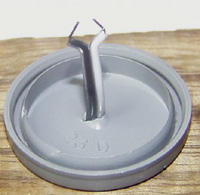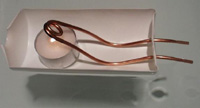Science Toys You Can Make With Your Kids
Best amateur science source
Probably the coolest source of educational science demonstrations I’ve encountered is this very book-like website written and run by Simon Field. Field has 30 nifty toys and gadgets that can be made quickly, cheaply and will amaze adults as well as kids. This is the only place I’ve seen that tells you how to make a magnetic linear accelerator, also known as a Gauss Rifle – it uses magnetism to shoot tiny steel balls. The secret to Field’s method is that his demos are very small, requiring small amounts of material, energy, or money. Most of his experiments can be assembled – even if you buy the stuff – for a few dollars, and can fit in your palm. His instructions and visuals are simply the best I’ve seen in any how-to-book. Most wonderful of all, it’s entirely up on the web for free. Hats off to you, Mr. Field. (He does sell kits, and parts, which may help pay for his server, I guess.)
— KK
Science Toys You Can Make With Your Kids
Building the Film Can Cannon
This toy was an instant favorite from the moment its first loud Bang! and flash of orange flame launched the little black film can up to bounce off our 26 foot ceiling. It has several names: the Piezo-Popper, the Binaca Bomb, the Photo-Flash — you will probably come up with more.
The toy is very easy to make, going together in about 15 minutes, at a cost of two or three dollars if all the parts are purchased new, or free if you don’t throw away certain common household items.
The fuel for the cannon can be found around the house. We have run ours on perfume, hair spray, and (our favorite) Wintergreen Binaca mouth freshener.
The cannon is very simple. A pair of wires are pushed through a slit made in the top of a plastic 25 millimeter film can. The other end of the wires are soldered to the igniter element from an electronic cigarette or fireplace lighter. I chose to mount these elements on a block of wood, but this is optional if you’re in a hurry.
To fire the cannon, you spray the fuel (one squirt of perfume or Binaca, or a very short squirt of hair spray) into the plastic film can, push the can down on the lid, and press the igniter.
With a loud Bang! and a flash of orange flame, the little can goes sailing into the air. With some practice in getting just the right amount of fuel in the can, it will go as high as 30 feet straight up. If too much or too little fuel is used, it will either not ignite at all, or it will not go very high.
The Film Can Cannon can only hold a small amount of air and fuel mixture, so it is safe to fire off in the house. The plastic can is soft and light, and can land on people without disturbing their hairdo. But it takes off rather quickly, and it is not recommended to have your head in the way during a launch.

Here is a closeup of the spark gap formed by the stripped ends of the two wires. There is nothing critical about this arrangement — as long as the wire ends are bare and close enough, a spark can jump across the gap when the igniter is pushed.
*
The world’s simplest steam powered boat
This next toy is an example of the simplest steam engine you will ever see. It has no valves, no moving parts (in the traditional sense of the phrase), and yet it can propel it’s little boat easily across the largest swimming pool or quiet duck pond.








